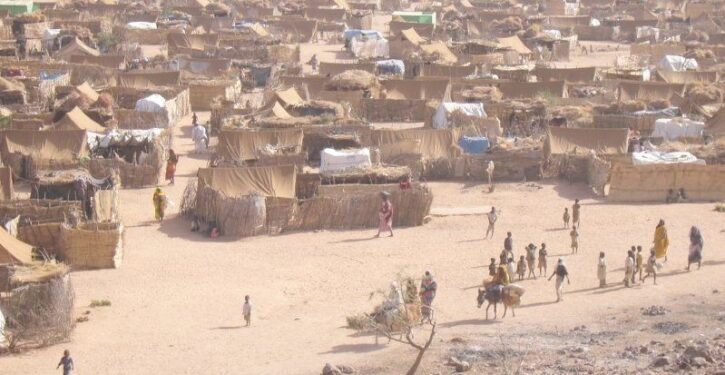
“More than half the people in Sudan, a nation of 50 million people, are suffering from severe hunger,” reports Reuters. Hundreds are dying from starvation and hunger-related diseases each day.
“But life-saving international aid – cooking oil, salt, grain, lentils and more – is unable to reach millions of people who desperately need it.” So people are slowly starving to death. That includes the family of Raous Fleg, a 39-year-old mother of nine. Her mother has died of starvation, and her kids are slowly starving to death, too. She lives in a vast displaced persons camp in South Kordofan, one of the poorer and more backward areas of Sudan, where she sought shelter from fighting in Sudan’s civil war.
“Since Fleg arrived nine months ago, United Nations food aid has gotten through only once – back in May. Her family’s share ran out in 10 days, she said. The camp, home to an estimated 50,000 people, is in an area run by local rebels who hold about half the state. The Sudanese army won’t let most food aid cross the lines of control into the area, aid officials say. So, every day after dawn, Fleg and other emaciated women from the camp make a two-hour trek to a forest to pick leaves off bushes. On a recent outing, several ate the leaves raw, to dull their hunger. Back at the camp, the women cooked the leaves, boiling them in a pot of water sprinkled with tamarind seeds to blunt the bitter taste.”
For Fleg and the thousands of others in the camp, that barely edible mush is their main source of food.
It is nowhere near enough. Some have starved to death. Fleg’s mother is one of them. “I came here and found nothing to eat,” Fleg says. “There are days when I don’t know if I’m alive or dead.
Famine has only been officially declared in one part of Sudan, but that’s because other parts of Sudan can’t even be accessed by the international hunger monitor that declares famines, the Integrated Food Security Phase Classification (IPC).
As The Economist notes, experts are projecting that six to ten million people will die of starvation and related diseases:
In May the Clingendael Institute, a Dutch think-tank, released a report which estimated that hunger and related diseases would kill more than 2 million people in Sudan by the end of the year. Timmo Gaasbeek, the report’s author, has since extended his projections to cover the next two years. In an “optimistic scenario”, in which fighting stops and this year’s harvest, expected in October, is slightly better than the last, he predicts around 6 million “excess deaths” by 2027. In the (more likely) scenario in which fighting continues until early next year, more than 10 million may perish. Although some experts have lower estimates, there is an emerging consensus that without decisive action Sudan faces mass starvation on a scale not seen in decades….
Last month, the water supply for the region containing one of Sudan’s largest cities (Port Sudan) was destroyed, when a dam collapsed, killing hundreds of people.
The RSF, the rogue militia that controls most of Sudan’s populated areas, interfered with harvests in Sudan’s breadbasket, Jazira state, which is “home to one of the largest irrigation systems in the world,” reported CNN. Thousands of farmers fled the RSF into areas controlled by Sudan’s military, leaving fields untended.
Sudan’s national museum was looted by the RSF. The museum housed “the world’s largest and most comprehensive Nubian archaeological collection, along with artifacts from other ancient civilizations including the Kingdom of Kush (8th-4th century BCE) and the medieval Kingdom of Alwa. The Nubian collection” included “embalmed mummies dating back to 2,500 BC, making them among the earliest and most important such examples in the world.” The museum also had some Christian relics from Sudan’s pre-Islamic period. Sudan, like Egypt, has pyramids and mummies.
Frankenstein’s monster turned on its creator, in Sudan. Over a decade ago, Sudan’s military created the Rapid Support Forces (RSF), a genocidal militia it used to wipe out villages inhabited by some African tribes in Sudan’s Darfur region. Now, this Frankenstein’s monster, the RSF, is fighting Sudan’s military in a civil war, and has taken over most of Sudan’s capital region, and its breadbasket region. It is slaughtering males from western Sudan’s black African Masalit tribe. It sexually enslaved some women, and raped others. The RSF committed mass killings and rapes to drive the Masalit ethnic group from Sudan into the neighboring country of Chad.
Tens of thousands of Sudanese have previously died of starvation during the war. Thousands of bodies were left decomposing in morgues in the country’s capital. At least 150,000 civilians were killed in fighting between Sudan’s warring factions.



